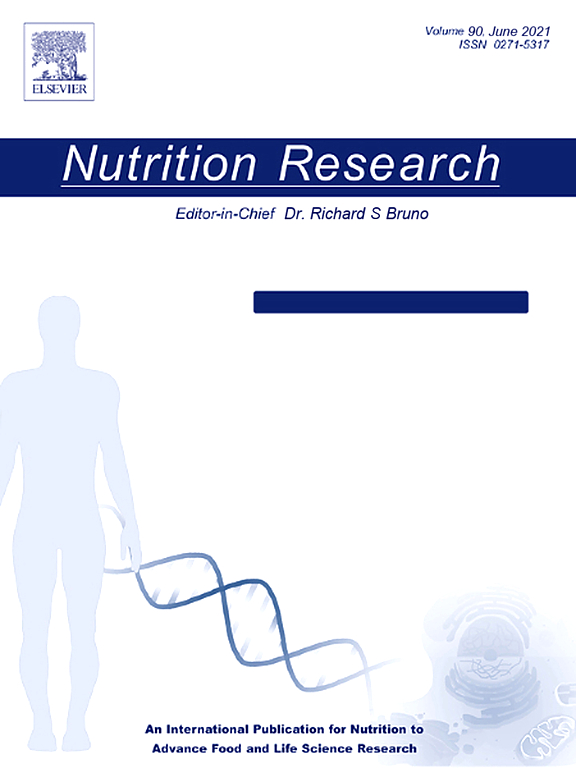Common Brazilian dietary pattern is associated with lower cardiovascular risk in adolescents
IF 3.1
3区 医学
Q2 NUTRITION & DIETETICS
引用次数: 0
Abstract
Studies on dietary patterns in adolescents can contribute to monitoring and prevention of cardiovascular diseases. Our hypothesis is that, in Brazilian adolescents, the coffee with bread and Common Brazilian dietary patterns are associated with a better cardiovascular profile, since they have previously been associated with a lower chance of being overweight. This study aims to verify the association between dietary patterns and cardiovascular risk (CVR) in adolescents using isolated and combined lipid variables in the form of indices. This is a cross-sectional study conducted with 825 adolescents from public schools. The dependent variables included alterations in total cholesterol, low-density lipoprotein cholesterol, high-density lipoprotein cholesterol (HDL-c), triglycerides, and non-HDL-c, as well as the Castelli I and II indices and the triglycerides/HDL-c ratio. Three dietary patterns were identified through principal component analysis: Coffee with bread, Common Brazilian, and Mixed. Regression models were used to assess the association of these patterns with isolated lipid alterations and indices. Greater adherence to the Common Brazilian pattern reduced the odds of having elevated total cholesterol by 49% (OR: 0.51; 95% confidence intervals [95% CI]: 0.28, 0.94), elevated low-density lipoprotein cholesterol by 70% (OR: 0.30; 95% CI: 0.12, 0.72), elevated non-HDL-c by 42% (OR: 0.58; 95% CI: 0.34, 0.98), even after adjustment for potential confounders. Greater adherence to the Common Brazilian pattern demonstrated a potential protective effect against CVR in adolescents. No associations were found between the Coffee with bread and Mixed patterns and CVR.
常见的巴西饮食模式与青少年较低的心血管风险相关
对青少年饮食模式的研究有助于监测和预防心血管疾病。我们的假设是,在巴西青少年中,咖啡加面包和常见的巴西饮食模式与更好的心血管状况有关,因为它们之前被认为与较低的超重几率有关。本研究旨在验证青少年饮食模式与心血管风险(CVR)之间的关系,采用单独和联合脂质变量的指数形式。这是一项对公立学校825名青少年进行的横断面研究。因变量包括总胆固醇、低密度脂蛋白胆固醇、高密度脂蛋白胆固醇(HDL-c)、甘油三酯和非HDL-c、Castelli I和II指数以及甘油三酯/HDL-c比值的变化。通过主成分分析确定了三种饮食模式:咖啡加面包,普通巴西和混合。使用回归模型来评估这些模式与分离的脂质改变和指数的关联。即使在调整了潜在的混杂因素后,更严格地遵循巴西常见模式,总胆固醇升高的几率降低了49% (OR: 0.51; 95%可信区间[95% CI]: 0.28, 0.94),低密度脂蛋白胆固醇升高的几率降低了70% (OR: 0.30; 95% CI: 0.12, 0.72),非hdl -c升高的几率降低了42% (OR: 0.58; 95% CI: 0.34, 0.98)。在青少年中,更大程度地遵守共同巴西模式表明对CVR有潜在的保护作用。没有发现面包咖啡和混合模式与CVR之间的联系。
本文章由计算机程序翻译,如有差异,请以英文原文为准。
求助全文
约1分钟内获得全文
求助全文
来源期刊

Nutrition Research
医学-营养学
CiteScore
7.60
自引率
2.20%
发文量
107
审稿时长
58 days
期刊介绍:
Nutrition Research publishes original research articles, communications, and reviews on basic and applied nutrition. The mission of Nutrition Research is to serve as the journal for global communication of nutrition and life sciences research on diet and health. The field of nutrition sciences includes, but is not limited to, the study of nutrients during growth, reproduction, aging, health, and disease.
Articles covering basic and applied research on all aspects of nutrition sciences are encouraged, including: nutritional biochemistry and metabolism; metabolomics, nutrient gene interactions; nutrient requirements for health; nutrition and disease; digestion and absorption; nutritional anthropology; epidemiology; the influence of socioeconomic and cultural factors on nutrition of the individual and the community; the impact of nutrient intake on disease response and behavior; the consequences of nutritional deficiency on growth and development, endocrine and nervous systems, and immunity; nutrition and gut microbiota; food intolerance and allergy; nutrient drug interactions; nutrition and aging; nutrition and cancer; obesity; diabetes; and intervention programs.
 求助内容:
求助内容: 应助结果提醒方式:
应助结果提醒方式:


